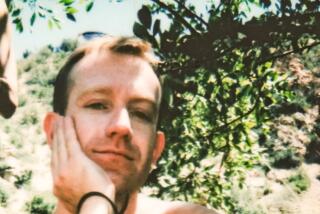It’s all in the genes
- Share via
WHEN we last heard from Michael Crichton, he had grown a giant-size petri dish full of controversy with his 2004 novel, “State of Fear,” the premise of which was that global warming was a hoax used to justify acts of eco-terrorism. The White House cozied up to Crichton and his ideas; most scientists in the field were unimpressed. Fans who have followed Crichton’s techno-thrillers through thick (“The Andromeda Strain,” “Jurassic Park”) and thin (“Disclosure,” in 1994, which fretted about the nonissue of sexual harassment of men by women) could be pardoned for wondering what’s next.
Well, “Next” is a novel about the implications of genetic research, legal and illegal, well-meaning and tainted by commercialism -- a subject that requires all of Crichton’s ingenuity to be stuffed into 400 or so pages along with all the sex, violence and skulduggery that the genre demands.
In “Next,” a Southern California cancer survivor, Frank Burnet, discovers that cells he let a trusted doctor harvest from his body because of their cancer-fighting characteristics have become the property of UCLA, which licensed a private firm, BioGen, to do research on them. When the cells, said to be worth $3 billion, are contaminated -- by agents of a predatory investor who wants the company to fail so that he can take it over -- UCLA and BioGen claim the legal right to extract more cells from Burnet, by force if necessary, invoking the same power of eminent domain for the sake of the public good that the government uses to take private land for freeways.
Burnet goes into hiding. Desperate, BioGen Chief Executive Rick Diehl hires a bounty hunter with a black Hummer and a doctor with a substance-abuse problem to kidnap and do biopsies on Burnet’s lawyer daughter, Alex, and 8-year-old grandson, Jamie, who have inherited the valuable cell strain.
There’s more, much more. If the human genome has tens of thousands of genes -- one-fifth of which, Crichton says, are already owned and patented by universities and drug companies -- it isn’t a whole lot more complicated than the plot of “Next.”
Just a sampler: While Alex and Jamie are fleeing from the bounty hunter, tourists in Sumatra are cursed in fluent French and Dutch by an orangutan that has human genes, the result of an experiment barred in Europe. A transgenic parrot named Gerard embarrasses people by reproducing the words they say and the sounds they make during illicit love scenes. A UC San Diego scientist, Henry Kendall, learns that sperm he donated to a federal primate research center in Maryland has produced a son, a 4-year-old transgenic chimpanzee named Dave. Dave is scheduled to be terminated -- this experiment too was illegal -- but Kendall sneaks him out of the facility, takes him home and tries to raise him as a normal child, though schoolmates call him “Monkeyboy” and a passing farmer sizes him up as stoop labor.
Crooked administrators at a Long Beach hospital sell dead patients’ bones and other body parts to tissue banks; family members are none the wiser. A Hollywood divorce lawyer seizes on adversarial genetic testing as yet another courtroom ploy. Teenage girls take fertility drugs and sell their eggs. Advertisers dream of implanting their messages in genetically altered fish and animals. A BioGen underling treats his drug-addicted brother with a “maturity gene” spray that he hopes will make him grow up. The problem is he also grows old -- fast.
Slick, sanctimonious Dr. Robert Bellarmino at the National Institutes of Health touts future genetic cures he doubts will ever happen. Bellarmino knows that individual genes don’t determine specific traits such as homosexuality, violence, high IQ, short stature or resistance to Alzheimer’s disease; their interaction with other genes and with the environment is staggeringly complex. But it’s good for the research business to pretend otherwise. When doctors bend the rules in long-odds attempts to provide the cures for inherited illnesses that the public demands, Bellarmino works to shield them from censure.
That all these stories and others finally mesh, however improbably, is a tribute to Crichton’s storytelling skill, and the documentation he sprinkles throughout the narrative teases us with speculation. (Will natural blonds go extinct in 200 years? Were Neanderthals smarter than we are? Are modern Americans, infantilized by higher education, incapable of growing up?)
To a point, we’re willing to forgive Crichton’s snarky put-downs of environmentalists and journalists, his hurried prose and characterization so basic that the transgenics -- especially Gerard, who is downright funny -- outshine the people.
Crichton has always specialized in worst-case scenarios. The question in each of his novels is whether the horror story convinces us. As entertaining as “Next” can be, it’s too monochromatic a picture of fecklessness and corruption to stand in credibly for the real world of genetic research.
On a more abstract level, however, Crichton is surely on to something: That world is changing so fast that public education, the media and the legal system have failed to keep up, and we risk being blindsided by tomorrow’s challenges to our notions of what’s possible and moral.
For readers who, after finishing the book, will shrug helplessly and ask, “What should we do about all this?” Crichton offers five policy recommendations, including halting the patenting of genes, avoiding bans on research and establishing clear guidelines for the use of human tissues.
Who knows? Washington might still be listening.
*
Michael Harris is a book critic and the author of the novel “The
Chieu Hoi Saloon.”
More to Read
Sign up for our Book Club newsletter
Get the latest news, events and more from the Los Angeles Times Book Club, and help us get L.A. reading and talking.
You may occasionally receive promotional content from the Los Angeles Times.








